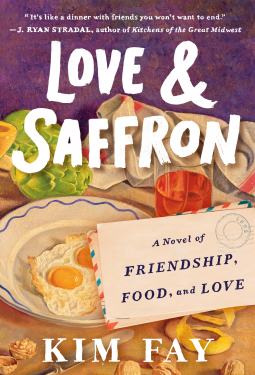Imogen Fortier lives with her husband Francis outside of Seattle, but it’s her time spent at their cabin on Camano Island that she writes about in her monthly column “Letter from the Island” for Northwest Home & Life Magazine. It’s this column that brought her to the attention of a young woman in Los Angeles, Joan Bergstrom.
Joan was such a fan of the column and of Imogen that she writes a lovely letter to her, explaining how much her column meant to her and noting that in the last column, Imogen had mentioned mussels as if they were merely a nuisance. Joan suggests that Imogen collect some and eat them, suggesting a recipe and even sending some saffron Imogen can use on the mussels, which was not something that was easy to come by in 1963.
Imogen writes Joan back, saying thank you and expressing how much she and Francis had enjoyed the mussels, preparing them as Joan had suggested. And a beautiful friendship is born. As the women write back and forth about food and life, their friendship develops strong flavors and textures. They talk of risotto and relationships, carne asada and the current events. They share their anxiety of the Cuban Missile Crisis, their grief at the assassination of John Kennedy, their mutual dislike of Helen Gurley Brown’s Sex and the Single Girl, even while feeling proud and hopeful for what the future holds for women.
Despite their age difference (Imogen is almost 60 when they first start writing, and Joan is in her early 30s), the women find a connection that can’t be broken by distance or lifestyle. As Joan talks about her forays into international cuisines she finds in L.A., Imogen becomes more open to new adventures and new recipes too. As Imogen finds that the saffron reminds her husband of some of the meals he ate while in France during the war, something he’d never been willing to talk about before, Joan finds herself at a new job where she can write about her love of food. While Imogen’s husband Francis starts cooking from Julia Child’s Mastering the Art of French Cooking and arguing with new friend Angelo Pelligrini about whether French or Italian food is better, Joan is finding herself falling for the man who taught her everything he knows about Mexican food.
As these women share their recipes, their fears, their triumphs, and their loves, they discover a friendship as delicious as any meal they’ve ever had. As as the friendship grows deeper, their individual lives expand in new and surprising ways, even as the culture around them changes. But mostly, it’s about the love. These women love food, they love their families, and they love each other.
Love & Saffron is a lovely tale of female friendship, told mostly through letters. As the months and years go by in their friendship, the things that Imogen and Joan experience tell a story of a powerful time in American history. The 1960s were a time of political upheaval but also a time when women were starting to come into their own, opening up new choices for them and making international recipes and ingredients accessible to more people. While this book is short, it manages to convey a lot in what’s written between the lines in these letters. And what’s said and not said between these women is a life’s worth of experiences.
I adored this book. I thought it was beautifully efficient, packing big emotional punches in short paragraphs. It’s a quick read, but it offers a lot to think about or to talk about with your best friend. You get a taste of life back in the ‘60s as well as beautiful descriptions of foods and travel. These women are strong and courageous and willing to write about what’s most important to them. Getting to be a party to their friendship was an honor, and I would recommend this short book to readers young and old. If I could change anything, it would be to read more of the columns that these ladies wrote for their respective publications, but this is exceptional as is. Read it and cook and eat and share and enjoy.
Egalleys for Love & Saffron were provided by G.P. Putnam’s Sons through NetGalley, with many thanks.

